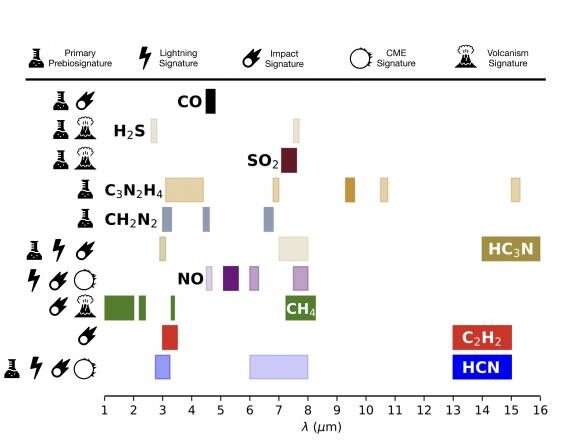This article has been reviewed according to Science X's editorial process and policies. Editors have highlighted the following attributes while ensuring the content's credibility:
fact-checked
preprint
trusted source
proofread
Webb Telescope is powerful enough to see a variety of biosignatures in exoplanets, argues new paper

The best hope for finding life on another world isn't listening for coded messages or traveling to distant stars, it's detecting the chemical signs of life in exoplanet atmospheres. This long hoped-for achievement is often thought to be beyond our current observatories, but a new study argues that the James Webb Space Telescope (JWST) could pull it off.
Most of the exoplanets we've discovered so far have been found by the transit method. This is where a planet passes in front of its star from our point of view. Even though we can't observe the planet directly, we can see the star's brightness dip by a fraction of a percent. As we watch stars over time, we can find a regular pattern of brightness dips, indicating the presence of a planet.
The star dips in brightness because the planet blocks some of the starlight. But if the planet also has an atmosphere, there is a small amount of light that will pass through the atmosphere before reaching us. Depending on the chemical composition of the atmosphere, certain wavelengths will be absorbed, forming absorption spectra within the spectra of the starlight. We have long been able to identify atoms and molecules by their absorption and emission spectra, so in principle, we can determine a planet's atmospheric composition with the transit method.
While the idea is straightforward, putting it into practice is difficult. For one, starlight isn't just a steady stream of light. There are flares, starspots, and other turbulence that causes noise in the signal. Even just detecting planetary brightness dips is difficult because of this. And while a planet will block less than a percent of the light, the amount of starlight passing through an exoplanet's atmosphere is truly minuscule. It would take multiple transits with extremely detailed spectra observations to detect atmospheric spectra.

We have done this with a few exoplanets, such as detecting the presence of water and organic compounds, but these were done for large gas planets with thick atmospheres. We haven't been able to do this with rocky Earth-like worlds. Our telescopes just aren't sensitive enough for that. But this new study, available on the arXiv pre-print server, shows that the JWST could detect certain chemical biosignatures depending on their abundance in the atmosphere.
The team simulated atmospheric conditions for five broad types of Earth-like worlds: an ocean world, a volcanically active world, a rocky world during the high bombardment period, a super-Earth, and a world like Earth when life arose. They assumed all these worlds had a surface pressure of less than five Earth atmospheres, and calculated the absorption spectra for several organically produced molecules such as methane, ammonia, and carbon monoxide. These molecules can also be formed by non-biological methods, but they form a good baseline as a proof of concept.
They found that with a reasonably thick atmosphere, the JWST, specifically its NIRSpec G395M/H instrument, could confirm the presence of these molecules within 10 transits of the planet. It would be easiest to do with super-Earths and other worlds with a thick atmosphere, but it is still possible for potentially habitable worlds.
Given the number of transits needed, our best shot at detecting biosignatures with JWST would be the close-orbiting worlds of red dwarf stars, such as the Trappist-1 system, which has several potentially habitable Earth-sized planets. Given the overlap between biological and non-biological origins, JWST observations might not be enough to confirm the existence of life, but this study shows that we are very close to that ability.
More information: Alastair Claringbold et al, Prebiosignature Molecules Can Be Detected in Temperate Exoplanet Atmospheres with JWST, arXiv (2023). DOI: 10.48550/arxiv.2306.02897
Journal information: arXiv
Provided by Universe Today





















